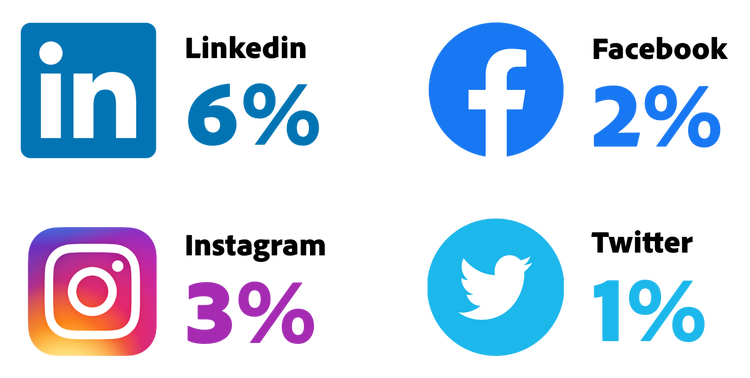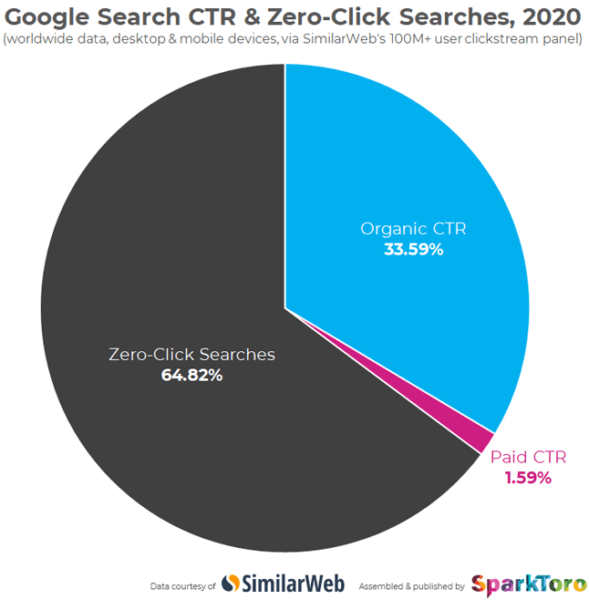We’re glad you made it to this page! It tells us that you clicked your way here from whatever source you came from.
Why does that matter? Because that’s the whole point of this post – zero click searches and their effect on modern marketing strategies.
Sites like Google are clawing tooth and nail to keep users on their results pages, creating less and less need to navigate to websites directly.
And this poses a challenge for marketers: How are we supposed to convert leads to our brand if they can’t even engage with us on our websites? When you pour tens of thousands of dollars into making your website into a lead engine, what are you supposed to do when people are being ushered away from your site?
We’ll talk about all of it here.
The Evolution of Engagement Rates
Remember the good ol’ days when Facebook posts boasted a click-through rate of 10%? It seems like a lifetime ago, doesn’t it? Back then, a 15% engagement rate was considered the gold standard, and we reveled in the organic engagement that came our way.
But times change, algorithms evolve, and now a mere 2% is hailed as a miraculous engagement rate (on Facebook – for other sites it’s a little different):

So what changed? It’s the platforms themselves. They’ve gotten so clever at keeping people there, deterring them in every way possible from navigating away from the site.
It’s part of what Google is striving tirelessly to accomplish so that they can stay the number one preferred search engine for entire world. Their solution, of course, is to keep people from wandering off their platform.
Their perspective is that they’ll continue being people’s preferred choice if they get better at satisfying their query faster, which ultimately translates to removing the need entirely for accessing the actual websites that contain the answers.
The Zero Click Content Landscape
Now, let’s dissect this concept a bit further.
A recent analysis by Rand Fishkin, a voice we greatly respect in the industry, outlines the zero click content landscape across major platforms:

Platforms like Google, YouTube, Instagram and LinkedIn are the big players here, and they have a common goal: to prioritize native content. In other words, if you’re sharing content directly on these platforms without external links, you’re in for a treat.
Why, you ask? Because the algorithms on these platforms reward creators who keep users engaged on-site. Sites like Google don’t really like it when brands dip their toes into the platform just enough to show their audience ads, only to scoop them away from the hosting site (i.e., the media platform).
Why do they care so much? Because it affects their participation numbers and their own propensity to grow revenue. Plus, they want to be treated as the end source point for all of their users’ needs.
When platforms like Facebook foster a mindset where they have the content that people need and want, they’re effectively keeping them away from other sites. When they do that, it gives them more opportunity to reap benefits from theirs users, like serving them ads.
Every media platform wants to be treated like an exclusive club where once you’re in, you’re in, and there’s no getting out. Grim as it sounds, and it is somewhat tongue-in-cheek, there’s a grain of truth to it.
And let’s face it, that makes perfect business sense. The longer users stay, the more ads they’re exposed to, which leads to higher revenue. So, if you’re posting your witty content natively on platforms like Instagram or Twitter, you’re in the sweet spot of the zero click approach.
Embracing the Zero Click Philosophy
Rand Fishkin puts forth a bold idea:
The future of marketing lies in the zero click approach.
What does that mean?
Well, it suggests that we need to fine-tune our content to captivate users within the platform itself. The days of depending on outbound links to reel in your audience are gradually fading.
Now we’ve got to play by the new rules that search engines and social media platforms are imposing. Is it annoying? For now, yes it is. But we’ve all had to adapt to these platforms in the past. So this is just another instance of change that we have to adjust to. We must embrace the future!
Now, the challenge lies in crafting content that sparks curiosity, making users curious enough to Google your brand organically.
Think about it. Even if your content doesn’t generate clicks, it still contributes to brand building. The mere presence of your brand on these platforms lays the foundation for familiarity. And, as we all know, familiarity breeds trust and (eventually) engagement and conversions.
Data Speaks: The Rise of Zero Click Searches
Let’s delve into some numbers.
Back in 2020, zero click searches accounted for a whopping 65%:

Fast forward to today, and that number is likely even higher. Paid click-through rates are inching upward, while organic rates are witnessing a slight decline. This is a testament to the evolving dynamics of user behavior and platform strategies.
As the great Charlie Munger once said, “Show me the incentive, and I’ll show you the outcome.”
And the incentive is clear. Platforms are incentivized to keep users engaged in-house, making the zero click approach the prevailing trend.
Cracking the Platform Code
So, with that all said, the next logical question we must ask ourselves is: How do we navigate this daunting notion of zero click marketing?

The first step in thriving through zero click marketing is to tailor your content strategy to the unique dynamics of each platform. Think of it as deciphering the distinct dialects of a multi-lingual audience.
When crafting content for YouTube, for instance, remember that a mere thumbnail and headline hold the power to drive your click-through rates. A visually arresting thumbnail coupled with a headline that sparks curiosity can be the difference between a mere glance and a resounding click.
Moving over to the professional terrain of LinkedIn or the visually driven realm of Instagram, native content emerges as your staunch ally. These platforms thrive on content that seamlessly blends into the user’s feed, mirroring the style and substance they’ve grown accustomed to.
Bye Bye Outbound Links, Hello Native Engagement
As we step into the dawn of a new era, we’re bidding farewell to the antiquated reliance on outbound links to channel traffic.
Instead, we’re embracing a mindset that aligns with the very essence of the platforms themselves. Think of it as immersing yourself in the local culture while exploring a foreign land – to truly understand the natives, you must live and breathe as they do.
The paradigm has shifted. No longer is the quantity of clicks the sole measure of success; it’s the quality of engagement that reigns supreme. The algorithms that govern these platforms have come to appreciate and amplify content that keeps users within their confines.
It’s akin to crafting a captivating tale that keeps readers spellbound within its pages, rather than pushing them to flip to the next chapter.
Final Thoughts on Zero Click Searches and the Future of Marketing
The days of gauging success solely by click quantities have given way to an era where the quality of engagement takes center stage.
Platform algorithms now prioritize content that captivates and retains users within their confines, like a masterful tale that beckons readers to stay entranced within its pages.
The rise of zero click searches signifies a turning point where brands must immerse themselves in the specific culture of each platform, resonating with their audiences in authentic and relevant ways.
If you need help with your zero click search strategy, Single Grain’s content marketing strategists can help you!👇
Repurposed from our Marketing School podcast.



